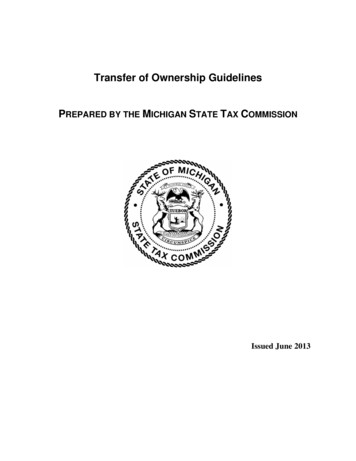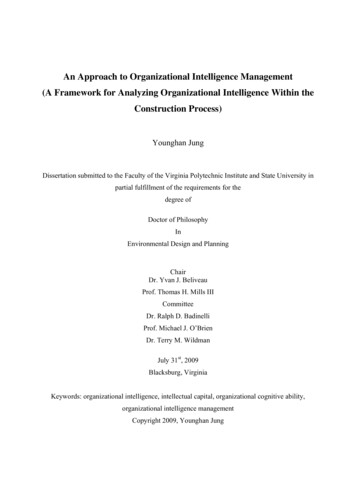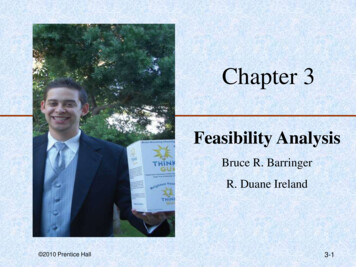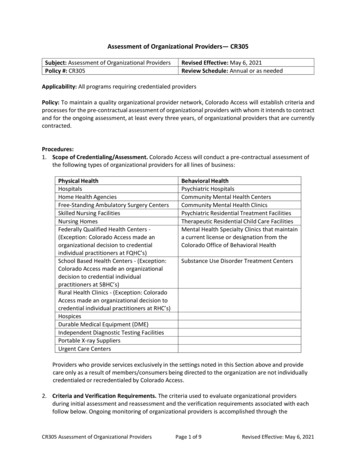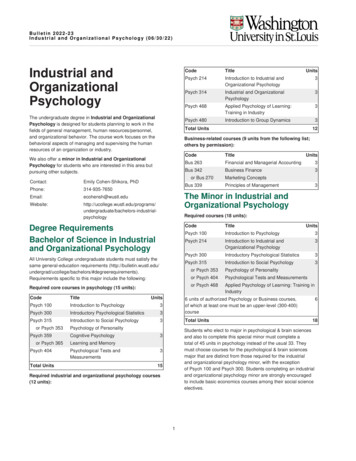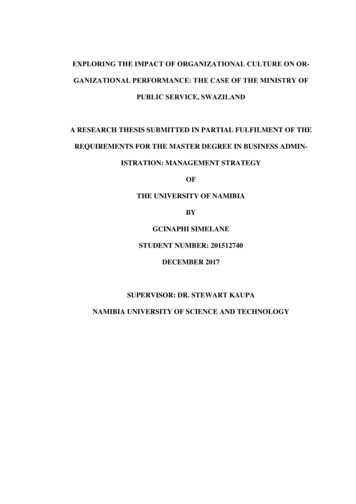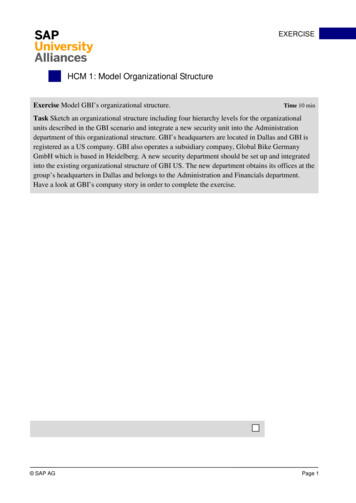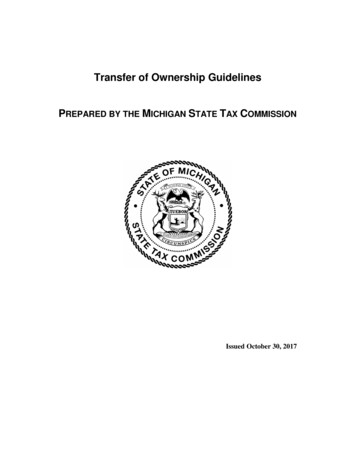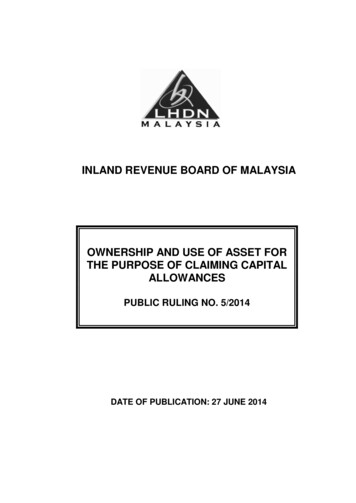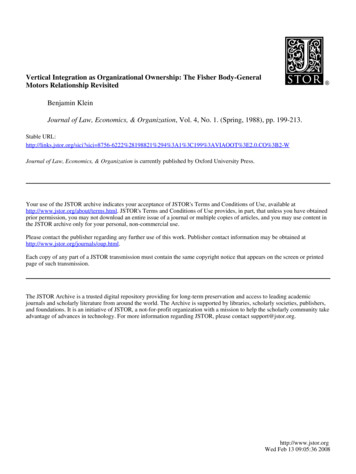
Transcription
Vertical Integration as Organizational Ownership: The Fisher Body-GeneralMotors Relationship RevisitedBenjamin KleinJournal of Law, Economics, & Organization, Vol. 4, No. 1. (Spring, 1988), pp. 199-213.Stable URL:http://links.jstor.org/sici?sici %3B2-WJournal of Law, Economics, & Organization is currently published by Oxford University Press.Your use of the JSTOR archive indicates your acceptance of JSTOR's Terms and Conditions of Use, available athttp://www.jstor.org/about/terms.html. JSTOR's Terms and Conditions of Use provides, in part, that unless you have obtainedprior permission, you may not download an entire issue of a journal or multiple copies of articles, and you may use content inthe JSTOR archive only for your personal, non-commercial use.Please contact the publisher regarding any further use of this work. Publisher contact information may be obtained athttp://www.jstor.org/journals/oup.html.Each copy of any part of a JSTOR transmission must contain the same copyright notice that appears on the screen or printedpage of such transmission.The JSTOR Archive is a trusted digital repository providing for long-term preservation and access to leading academicjournals and scholarly literature from around the world. The Archive is supported by libraries, scholarly societies, publishers,and foundations. It is an initiative of JSTOR, a not-for-profit organization with a mission to help the scholarly community takeadvantage of advances in technology. For more information regarding JSTOR, please contact support@jstor.org.http://www.jstor.orgWed Feb 13 09:05:36 2008
Vertical Integration as OrganizationalOwnership: The Fisher Body-General MotorsRelationship RevisitedBENJAMIN KLEINUnioersity of Calqornia, Los AngelesI have always considered my work with Armen Alchian and Robert Crawford(1978) on vertical integration to represent an extension of Coase's classicarticle on "The Nature of the Firm." By focusing on the "hold-up" potentialthat is created when firm-specific investments are made by transactors, orwhat we called the appropriation of quasi-rents, I believed we had elucidatedone aspect of the Coasian concept of transaction costs associated with marketexchange. We hypothesized that an increase in firm-specific investments, byincreasing the market transaction costs associated with a hold-up, increasedthe likelihood of vertical integration. This relationship between firm-specificinvestments, market transaction costs, and vertical integration was illustratedby examining the contractual difficulties that existed when General Motorspurchased automobile bodies from Fisher Body and the corresponding benefits that were created when the parties vertically integrated.It is clear from Coase's lectures that he considers our analysis not torepresent an extension of his earlier work, but rather to be an alternative,incorrect explanation for vertical integration (1988: lecture 3). Coase recognizes that an increase in the quasi-rents yielded by firm-specific investmentscreates a hold-up potential. However, he argues that there is no reason tobelieve that this situation is more likely to lead to vertical integration thanto a long-term contract. Although long-term contracts are imperfect, opporI am grateful to Harold Demsetz, Kevin James, Timothy Opler, and Oliver Williamson foruseful comments.Journal of Law, Economics, and Organization vol. 4, no. 1 Spring 19880 1988 by Yale University. All rights reserved. ISSN 8756-6222
200 / JOURNALOF LAW, ECONOMICS, AND ORGANIZATION IV:l, 1988tunistic behavior is usually effectively handled in the marketplace, accordingto Coase, by a firm's need to take account of the effect of its actions on futurebusiness. Coase claims that before writing his classic paper he explicitlyconsidered opportunistic behavior as a motive for vertical integration, inparticular as it applied to the General Motors-Fisher Body case, and explicitly rejected it.Unfortunately, Coase's rejection of the opportunism analysis is based upontoo simplified a view of the market contracting process and too narrow aview of the transaction costs associated with that process. A more completeanalysis of how vertical integration solved the opportunistic behavior problemin the Fisher Body-General Motors case provides insight into the nature ofthe transaction costs that are associated with the market contracting processand how vertical integration reduces these costs. The primary transactioncosts saved by vertical integration are not the "ink costs" associated with thenumber of contracts written and executed but, rather, are the costs associatedwith contractually induced hold-ups. The analysis indicates that hold-up potentials are created not solely from the existence of firm-specific investments,but also from the existence of the rigidly set long-term contract terms thatare used in the presence of specific investments. Vertical integration, byshifting ownership of the firm's organizational asset, creates a degree offlexibility and avoids this contractually created hold-up potential, therebyresulting in significant transaction cost savings.1. LONG-TERM CONTRACTS AS SOLUTIONS TO AND CAUSESO F HOLD-UP PROBLEMSCoase is correct in believing that in many cases contractual arrangements,rather than vertical integration, can be and are used to solve hold-up problems. For example, consider the case of building a house on a piece of land.It is obvious that you would not build the house on land you had only rentedfor a short term. After the land lease expired the landowner could hold youup for the quasi-rents on your house investment. However, this does notmean that you need necessarily own the land, that is, vertically integrate,to solve this problem. The hold-up problem potentially could be solved bythe use of a long-term rental contract on the land negotiated before the housewas constructed. Since land is the type of input where anticipated qualityvariations are very small or nonexistent, a long-term rental contract is certainly a feasible way to minimize the hold-up potential without verticalintegration.The long-term exclusive dealing contract adopted by Fisher Body andGeneral Motors in 1919 can be explained as an analogous contractual meansto avoid a hold-up potential without vertical integration.' Since Fisher Body1. The contractual agreement between Fisher Body and General Motors can be found inthe minutes of the Board of Directors of Fisher Body Corporation for November 7, 1919.Analysis of this case is taken in part from Klein, Crawford, and Alchian (308-10).
VERTICAL INTEGRATION AS ORGANIZATIONAL OWNERSHIP/ 201had to make an investment highly specific to General Motors in the stampingmachines and dies necessary to produce the automobile bodies demandedby General Motors, a significant hold-up potential was created. After Fishermade the investment, General Motors could have attempted to appropriatethe quasi-rents from the investment by threatening to reduce their demandfor Fisher- roducedbodies, or even to terminate Fisher completely, if pricewere not adjusted downward. The exclusive dealing clause, which requiredGeneral Motors over a tekyear period to buy all their closed metal bodiesfrom Fisher Body, limited the ability of General Motors to opportunisticallythreaten Fisher Body in this manner. The contractual arrangement therebyreduced Fisher Body's reliance on General Motors' reputation and encouraged Fisher Body to make the specific investment.Although the ten-year exclusive dealing contractual arrangement protectedFisher against a General Motors hold-up, it created a potential for Fisher tohold up General Motors. Fisher could take advantage of the requirementthat General Motors could not purchase elsewhere by increasing price ordecreasing quality. The contract attempted to protect General Motors againstthis reverse hold-up potential by specifying a formula by which price wouldbe set over the ten-year period at a competitive level. In addition, in a furtherattempt to minimize the potential Fisher hold-up of General Motors, thecontract also included most-favored nation provisions so that the price couldnot be greater than what Fisher Body charged other automobile manufacturers for "similar" bodies. Such a "price protection" clause prevents a holdup because a price increase or decrease to any buyer is guaranteed to begiven to all buyers. Hence, established buyers that are "locked-in" by aspecific investment or a contractual commitment are protected by the seller'sdesire to make profitable new sales.In spite of the existence of a long-term contractual arrangement withexplicitly set price and price protection clauses, there is still some probabilitythat a hold-up may occur. This is because not all elements of future performance are specified in the contract. Due to uncertainty and the difficulty ofspecifying all elements of performance in a contractually enforceable way,contracts will necessarily be incomplete to one degree or another. Thiscreates the possibility for transactors to take advantage of the contract tohold-up their transacting partner. For example, the long-term land rentalcontract in the house construction example may permit the landowner tohold-up the house owner by opportunistically controlling the water supplyto the house, or by failing to build a wall to prevent erosion of the land underthe house, or by closing a road on the land for claimed repairs and therebythreatening to restrict access to the house.Even though contracts are incomplete, the reputations of the transactingparties limit the economic feasibility of hold-up threats. It is the magnitudeof these reputations and the corresponding costs that can be imposed on atransactor that attempts a hold-up that define what can be called the "self-
202 / JOURNAL OFLAW, ECONOMICS, AND ORGANIZATION 1V:l. 1988enforcing range" of the contractual relationship. Transacting parties entercontractual arrangements by making specific investments and setting contractterms in such a way so that they are likely to be within this self-enforcingrange where a hold-up will not occur. However, there is some probabilitythat market conditions may change (for example, the value of the quasi-rentsaccruing to one of the parties unexpectedly increases) so that it pays for onetransactor to hold-up the other in spite of the loss of r e p u t a t i n . For example, in the General Motors-Fisher Body case demand for theclosed metal bodies manufactured by Fisher increased dramatically. Whenthe contract was entered into in 1919 the dominant production process forautomobiles consisted of individually constructed, largely wooden, open bodies; closed metal bodies were essentially a novelty. Demand for closed metalbodies grew extremely rapidly and by 1924 accounted for more than 65percent of General Motors' automobile production.3 This shift in demandmoved the contractual arrangement outside of the self-enforcing range andmade it profitable for Fisher to hold up General Motors.Although Fisher could have taken advantage of many imperfectly specifiedterms of the contractual arrangement, such as delivery times or quality characteristics, Fisher effectively held up General Motors by adopting a relativelyinefficient, highly labor-intensive technology and by refusing to locate thebody-producing plants adjacent to General Motors assembly plant.4This holdup mechanism had the advantage, from Fisher's viewpoint, of increasingprofitability since the contractually specified price formula set price equal toFisher's "variable cost" plus 17.6 percent, placing a 17.6 percent profit upcharge on Fisher's labor and transportation costs. The profit upcharge presumably was designed to cover Fisher's anticipated capital costs, which mayhave been difficult to isolate and measure for General Motors shipments and,therefore, were unreimbursable under the contract formula. The contractmay appear to be imperfect, but it was only deficient ex post. If demand hadnot grown so rapidly, Fisher's reputation (that is, loss of future business withGeneral Motors and possibly other automobile manufacturers) combined withthe most favored nation clause may have been an effective constraint onFisher Body behavior. However, the large increase in demand placed Fisher'sshort-run hold-up potential of General Motors, even with Fisher being forcedto give up new and future sales, outside the self-enforcing range.The Fisher Body-General Motors case illustrates that while long-term2. This probabilistic equilibrium differs from the analysis in Klein, Crawford, and Alchian,where hold-ups were assumed not to be present in long-run equilibrium and existed solelybecause of transactor myopia or ignorance. Kenney and Klein presents a discussion of the "selfenforcing range" and this equilibrium, together with the implications of the analysis for contractlaw.3. Sixteenth Annual Report, General Motors Corporation, year ended December 31,1924.4. See deposition testimony of Alfred P. Sloan, Jr, in United States v. Dupont C Co., 366U.S. 316 (1961), 186-90 (April 28, 1952) and 2908-14 (March 14, 1953).
contract terms and transactor reputations may prevent hold-ups and encourage specific investments by tying the hands of the transacting parties, longterm contract terms may also create hold-up problems. Therefore, it is misleading to assert, as Coase does, that "opportunistic behavior is usually effectively checked" in the market by long-term contracts and the existence oftransactor reputations. Although the assertion is true, a more complete analysis must recognize that transactor reputations are limited and that contractsmay actually create, rather than solve, hold-up problems. It was the longterm, fixed price formula, exclusive dealing contract adopted by the transactors in response to the potential General Motors hold-up of Fisher thatcreated the enormous Fisher hold-up potential of General Motors. The magnitude of this contractually caused hold-up was likely much greater than thequasi-rents on the General Motors-specific investments made by Fisherwhich the contract was attempting to protect in the first place. Althoughwriting down binding contract terms may economize on limited brand namecapital and reduce the probability of being outside the self-enforcing range,the rigidity of long-term contract terms may create a much larger hold-uppotential if events actually place the parties outside the self-enforcing range.To avoid this rigidity transactors may intentionally leave their contracts incomplete and thereby give themselves "an out" if market conditions get "outof line."It is this contractually induced hold-up potential and the costs associatedwith rigid ex-post incorrect contract terms, illustrated so forcefully in theFisher-General Motors case, that represent the major transaction costs ofusing the market mechanism to solve the hold-up problem. These transactioncosts include the real resources transactors dissipate in the contractual negotiation and renegotiation process in the attempt to create and execute ahold-up. Transactors will search for an informational advantage over theirtransacting partners and attempt to negotiate ex-ante contract terms thatcreate hold-up potentials, that is, that are more likely to imply ex-post situations where contract terms are favorably incorrect. Once such a favorablyincorrect situation arises, transactors will dissipate real resources during therenegotiation process in the attempt to convince their transacting partnerthat a hold-up potential does exist. In the Fisher-General Motors case theserenegotiation transaction costs consisted of the costs associated with improper plant placement and low capital intensity of production before verticalintegration 0ccurred.j5. In addition to the transaction costs associated with negotiating contractual arrangementsand the transitional transaction costs associated with the renegotiating process when thesearrangements do not work out in practice, there are the social costs associated with transactorsnot making specific investments and entering contractual arrangements to begin with. Transactors anticipate the rent-dissipating transaction costs associated with contractual negotiationand renegotiation because they recognize the limits to their reputation capital, the uncertaintyof the world, and the necessary imperfections of contracts. Therefore, independent of any risk
204 / JOURNALO F LAW, ECONOMICS, AND ORGANIZATION IV:l, 1988These transaction costs associated with the use of a long-term contractrepresent the theoretical reason why the presence of firm-specific investments are more likely to lead to vertical integration. Specific investmentscreate the necessity for long-term contractual terms which, in turn, implythe rent-dissipating transaction costs associated with the possibility of contractually created hold-ups. In the absence of specific investments, longterm contract terms are unnecessary and spot contracts can be used. Sincethe costs associated with vertical integration are generally incentive-typecosts that are unrelated to the level of specific investments, vertical integration will be more likely the greater the level of specific investments. Thegreater the level of specific investments and hence the greater the potentialcosts of using the market (as more explicit and rigid contractual mechanismsmust be devised to protect the specific investment), the greater the likelihoodthat vertical integration will be the solution.2. PHYSICAL CAPITAL VS HUMAN CAPITALVertical integration is the form in which the hold-up of General Motors byFisher Body eventually took place, with General Motors acquiring the FisherBody stock owned by Fisher at terms that were highly favorable to Fisher.Why did not General Motors merely make a lump sum cash payment toFisher and renegotiate the contract, fixing ambiguous terms and hoping thatanother large unanticipated event would not occur in the future to shock therelationship out of the self-enforcing range? One reason is that the changein demand to closed metal bodies made Fisher a much more importantspecialized input supplier to General Motors, with the Fisher hold-up potential reaching essentially the entire General Motors industry-specific investment. In principle, with an ex-post incorrect contract, Fisher couldpotentially hold up General Motors for their entire automobile manufacturingand distribution organization. This enormous hold-up potential would implyextremely large rent-dissipating transaction costs during the contractual negotiation and renegotiaton process as General Motors attempted to protectagainst and Fisher attempted to take advantage of the hold-up possibilities.Vertical integration appears to avoid these transaction costs by eliminatingthe second transactor. This is obvious for cases of physical capital, such asthe house construction-land ownership example, where a hold-up, by definition, becomes impossible with vertical integration. It is cases like theseaversion, transactors will avoid entering contractual arrangements where there is a significantprobability that the arrangement will not work out. The equilibrium contractual arrangementsthat transactors voluntarily adopt in the marketplace may appear, consistent with Coase's assertion, to handle opportunistic behavior-in the sense that we are unlikely to observe opportunism occurring very frequently. However, we do not see all the specific investments not madeand the contractual arrangements not adopted when transactors anticipate a significant probability of being outside the self-enforcing range.
that lead to the obvious conclusion that vertical integration will more likelybe used when the hold-up potential, that is, the quasi-rents from firm-specific investments, are large. As Joskow (1988)convincingly demonstrates, thisinsight regarding the economic motivation for ownership of firm-specificphysical capital has significant empirical relevance.However, many real-world examples involve human capital and not merelyphysical capital as the important firm-specific asset.6 Since the specific humancapital is embodied in individuals who by law cannot be owned and whohave the potential to behave opportunistically under any alternative organizational arrangement, vertical integration does not eliminate the othertransactor and the hold-up problem. In such cases it is unclear exactly whatgains are entailed by vertical integration.To understand the gains from vertical integration in the context of humancapital, the economic question should be phrased not (as we have done inthe house construction-land ownership case) as whether to own or rent anasset, but, as Coase essentially phrased it, as whether to make or buy aninput. The former question applies only to physical capital while the latterquestion applies to human capital. When a firm buys an input in the marketplace, it generally does not own the physical capital associated with itsproduction. A firm that produces an input itself also may not own the physicalcapital associated with its production (for example, the building where thefirm has its offices). However, as we shall see, a firm that makes rather thanbuys an input generally has a particular relationship with the firm-specifichuman capital.These issues can be focused by considering the Fisher Body-GeneralMotors case again. If the hold-up problem were based solely on the GeneralMotors-specific physical capital investments made by Fisher Body and hadnothing to do with Fisher Body human capital, General Motors could havesolved the problem by owning the physical capital. General Motors couldhave owned their own dies and stamping machines and let Fisher use thiscapital to make auto bodies for them, avoiding the hold-up problem whiletaking advantage of whatever cost advantage Fisher possessed in producingbodies.'6. See, for example, the discussion in Klein, Crawford, and Alchian (313-191 and Williamson (240-45).7. Coase discusses this as a particular contractual solution to the hold-up problem (1988:lecture 1). See also Monteverde and Teece. Fisher's cost advantage was unlikely due to economies of scale in the production process. Evidence for this is the fact that, after demand growthand integration, Fisher supplied bodies solely to General hlotors. This is one difference betweenthe Fisher Body case and the A. 0. Smith case discussed by Coase (1988: lecture 3). Thereappears to be significantly greater econoniies of scale in producing automobile frames thanproducing autornobile bodies, with Smith supplying frames then and now to multiple automobilemanufacturers, thereby raising the cost of \rertical integration as a solution to the hold-upproblem (see Stigler). It is also important to note that the investment in automobile frameproduction is, apparently less buyer-specific than the investment in automobile body production.
206 / JOURNALOF LAW, ECONOMICS, AND ORGANIZATION IV:1, 1988One problem with this solution is that the extent of the General Motorsspecific physical capital investments is likely to be much greater than merelythe dies and stamping equipment. There are, for example, complementaryphysical capital investments that must be made by Fisher in plant, with theassociated questions of plant location and the assurance to Fisher of continuedGeneral Motors demand for the facility. These questions presumably wouldhave to be handled by contract. To avoid contractual rigidity and the inducedhold-up problems associated with ex-post incorrect contract terms GeneralMotors could own all the physical capital and merely contract with Fisher torun the operation. While such an arrangement would create marginal distortions regarding the use of the General Motors capital equipment byFisher, it would appear to solve the hold-up problem if the problem werebased solely on specific physical capital investments.However, much of the specific investment necessary to produce automobile bodies consists of Fisher human capital investments that, by definition,cannot be owned by General Motors. General Motors can finance! Fisher'shuman capital investments but would require some long-term fixed pricecontractual commitment to prevent Fisher from threatening to terminate therelationship if General Motors did not make a lump sum payment to themequal to the quasi-rents from the human capital investment. Vertical integration, in the sense of making Fisher an employee, rather than an independent contractor, does not eliminate the potential hold-up. As opposed tophysical capital, the specialized human capital would presumably still beowned by Fisher even after General Motors' vertical integration. Rather thanownership, a long-term contractual arrangement, with its associated rigiditiesand potential hold-up problems, must be used by the transactor . Since, by definition, one cannot own human capital, how did the verticalintegration of General Motors with Fisher reduce the hold-up problem? Asopposed to the case of physical capital, vertical integration did not eliminatethe Fisher brothers. After vertical integration General Motors no longerbought bodies from Fisher Body Corporation. After vertical integration General Motors "made" bodies with the assistance of Fisher. However, did making the Fisher brothers employees compared to being independentcontractors change things in any essential way? Although General Motorswould now own the plants and presumably be able to tell the Fisher brotherswhere to locate them, the Fisher brothers became employee managers withthe ability to hold up General Motors for their human capital-specific investments by threatening modification on some other dimension.8. For example, one contract term that is used in employment arrangements in the entertainment industry, where the employer may make a substantial transactor-specific investment,is a right of first refusal clause. This clause reduces the credibility of hold-up threats since itrequires the employee attempting to increase his wage by the amount of the quasi-rents fromthe employer's investment to threaten to quit working completely, rather than merely to threatento quit the firm and work elsewhere.
VERTICAL INTEGRATION AS ORGANIZATIONAL OWNERSHIP/ 2073. VERTICAL INTEGRATION AS ORGANIZATIONAL OWNERSHIPAlthough the use of an employee rather than an independent contractorarrangement may imply important legal differences and hence different constraints on the contracting process, such as the ease of termination by theemployer and the required loyalty of the employee, I agree with Coase thatthe employer-employee contract does not represent the essence of a firm.9The transition of the Fisher brothers from independent contractors to employees does not explain what General Motors gained through vertical integration.Vertical integration not only made the Fisher brothers employees of General Motors, but also converted all the employees of Fisher Body Corporationinto employees of General Motors. General Motors moved from "buying"automobile bodies to "making" automobile bodies by obtaining ownership ofthe Fisher Body organization, including all the labor contracts of the cooperating workers in that organization and all the knowledge of how to makeautomobiles contained in that organization. It is in this sense of owning afirm's set of interdependent labor contracts and the firm-specific knowledgeembodied in the organization's team of employees that an owner of a firmcan own the firm's human capital.1 Vertical integration may solve a hold-up potential even when it hinges onhuman capital and, hence, the number of transactors are not reduced by theintegration because it involves transferring ownership of a productive team.For example, if we consider the Fisher Body-General Motors case it is unlikely that it was the Fisher brothers themselves who possessed all the relevant firm-specific human capital information. It was much more likely thatthis information was possessed by the entire group of Fisher employees andwas embedded in the Fisher organizational structure. Vertical integrationdid not merely transfer the Fisher brothers from independent contractor toemployee status, but also transferred ownership of the Fisher organizationand the set of interdependent labor contracts to General Motors.The primary reason a hold-up cannot occur after such a transfer of rights9. See Coase (1988: lecture 3) where he identifies this as the main weakness of his 1937article.10. The concept of specific knowledge which affects a firm's production technology andwhich is vested in and transferable with the firm has been discussed by numerous authors.Rosen notes that such a firm-specific information asset may be created over time by the discoveryof trade connections and the assembly of an efficient "production team" and presents a modelwhere specific knowledge is acquired through (or as a by-product of) a firm's production experience. A similar concept is developed in Prescott and Visscher and is related to the evolutionary theory of the firm presented by Nelson and Winter. The importance of informationaccumulation within the firm as a kind of progress function was originally discussed by Alchian(1959)and Arrow. This concept may explain why bankruptcy law provisions, which are designedto prevent the production team from disbanding, make economic sense. While physical assetsgenerally may be salvageable, bankruptcy, accompanied by the discontinuance of a firm's operations, may destroy the organizational assets of the firm. The analysis also provides an emnomic justification for the "failing firm" defense in merger law.
208 / JOURNAL O F LAW, ECONOMICS, AND ORGANIZATION IV:l,1988is because collusion is difficult with a large number of entities. If there wereonly one employee or a few key employees, they could threaten to leave and(subject to legal constraints on trade secret or goodw
General Motors over a tekyear period to buy all their closed metal bodies from Fisher Body, limited the ability of General Motors to opportunistically threaten Fisher Body in this manner. The contractual arrangement thereby reduced Fisher Body's reliance on General Motors' reputation and encour- aged Fisher Body to make the specific investment.

